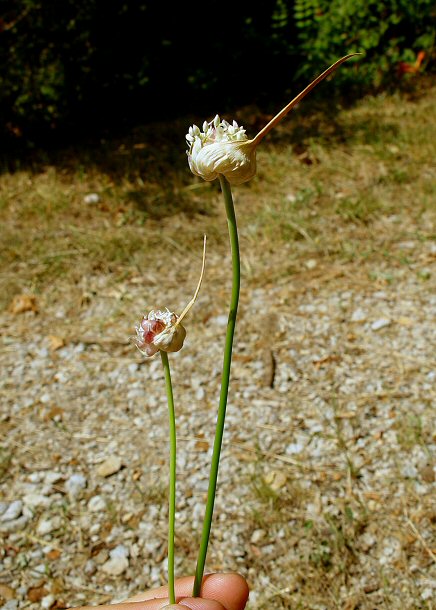Allium sativum L.
Garlic

Introduced
CC = *
CW = 5
MOC = 27
© DETenaglia
Allium sativum L.Garlic | |
 |
Introduced CC = * CW = 5 MOC = 27 |
© DETenaglia |
|
Family - Liliaceae Habit - Perennial forb from a bulb. Stems - Aerial stems to 1 m tall, erect, simple, herbaceous, green, glabrous, terete, mostly hollow. Bulbs 1.5-4.5 cm long, ovoid to nearly globose, differentiating into multiple bulblets, with a papery coating and fibrous roots. Bulblets with at least one side flattened.
Leaves - Alternate, straplike. Leaves present in the lower 1/3 to 1/2 of the stems. Leaves flat or very slightly folded, to 50 cm long, 7-15 mm broad, linear, glabrous, often glaucous, often with a prominent midrib, not tapered to a petiole, the long sheaths pale green to white.
Inflorescence - Dense terminal umbels, with some or all flowers replaced by sessile bulblets. Inflorescence covered in a papery spathe, this with a long apiculate tip, splitting on one side at anthesis. Flower stalks longer than the flowers.
Flowers - Flowers mostly or entirely replaced by bulblets. Bulblets glabrous, whitish or (more commonly) with a reddish tinge. If produced, the small flowers are greenish, whitish, or pinkish, the perianth bell-shaped to nearly tubular, the sepals and petals 2-4 mm long, narrowly elliptic, the tips pointed or blunt.
Fruits - Not produced. Flowering - May - July. Habitat - Waste ground, roadsides, railroads, fields, meadows, thickets, grassy areas. Origin - Progenitors native to Eurasia. Lookalikes - Other species of Allium. Other info. - This tasty species is the common "Garlic" of culinary fame. It can be found scattered throughout Missouri as escapes from cultivation. Native populations are not known. Many species of Allium appear similar. This one is recognized by leaves which are flat, relatively wide (up to 1.5 cm), and occurring on the lower stem rather than being all basal. The leaves are present at flowering time. The outer bulb coat is smooth and papery, without noticeable fibers (in contrast to A. canadense). Garlic is easy to grow in our area and wild plants can become weedy if left unchecked. Photographs taken somewhere in eastern Kansas, 7-4-03 (DETenaglia); also at St. Joe State Park, St. Francois County, MO, 5-21-2020 (SRTurner). |